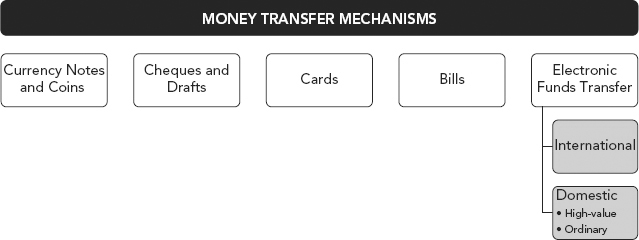Chapter Six
The Movement of Money
IN THIS CHAPTER, we look at the various forms of money and the methods in which money can be moved within a city, country, and internationally. We review some of the global payment systems in vogue and explore China as a case study of great improvement in the payments space.
MONEY TRANSFER MECHANISMS
Various methods have been used to move money over time, and different countries, depending on their state of evolution, use combinations of methods. Figure 6.1 shows some of these mechanisms for money transfer. These are:
FIGURE 6.1 Mechanisms of Money Transfer

- Currency notes and coins
- Cheques and drafts
- Cards
- Bills and negotiable instruments
- Electronic funds transfer
Bills are covered in more detail in Chapter 14. The other mechanisms are covered here.
Currency Notes and Coins
One of the earliest forms of exchange of value, currency notes and coins are still used for corporate transactions in many parts of the world. One of the benefits of using cash is that credit risk is eliminated, as is possible float—the cash is available in physical form and can be used immediately. However, some of the reasons for the reduced popularity of physical currency and hence for its being replaced as a transfer mechanism are:
- Loss of value (interest)
- Incremental operational issues
- Movement across a geography
- Only used for local currency settlements
- Storage
- Reconciliation/counting ...
Get The Handbook of Global Corporate Treasury now with the O’Reilly learning platform.
O’Reilly members experience books, live events, courses curated by job role, and more from O’Reilly and nearly 200 top publishers.

